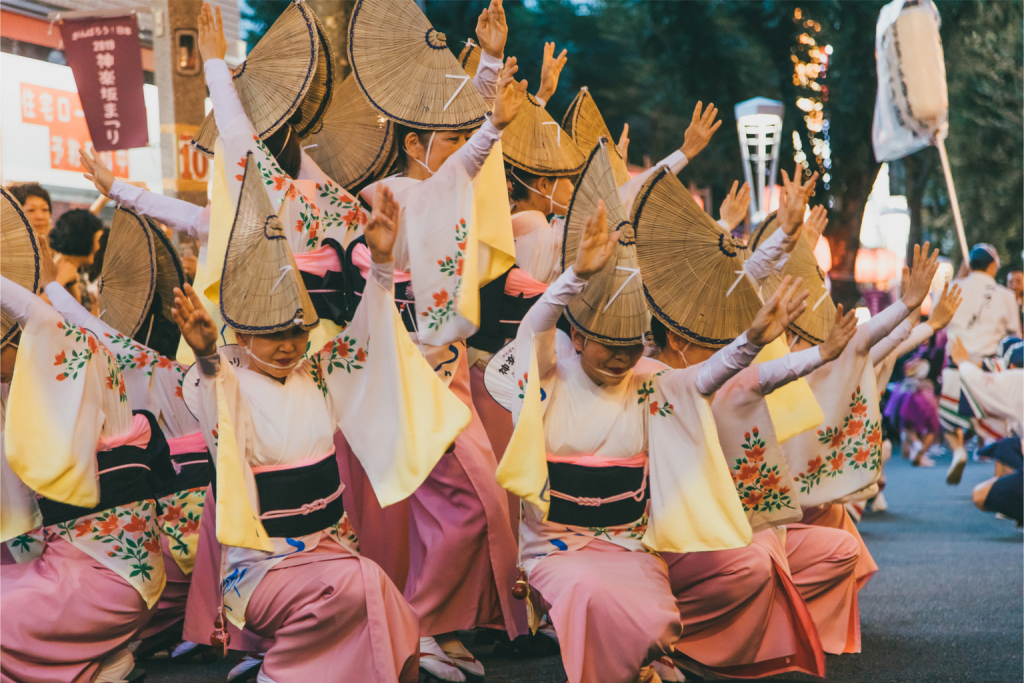The Koenji Awa-Odori is one of the biggest street festivals that Tokyo puts on during the summer. More than 10,000 dancers take to the streets of the western Tokyo neighborhood over the two-day event, and more than 1.2 million people come to watch them. But what are the origins of this massive dance party?
The Koenji version of the festival is heading into its 61st year, but as it turns out, this cultural celebration has very deep historical roots, and hails from Tokushima Prefecture, on the island of Shikoku.
The History of Awa-Odori
As it is with many of Japan’s older traditions, there are a few different theories about how the Awa-Odori dance party got its start, and all of them might have a bit of truth to them. The first element dates back to the dances of Buddhist priests, particularly one known as Kuya, a priest who lived during the 10th century. Not satisfied with merely chanting his prayers, this holy man set his orisons to dances that he made up, and he was particularly known for a dance called the nembutsu-odori. This choreographed version of the nembutsu – a chanting of the name of Buddha – caught on, and joined others, like the hiji-odori and the kumi-odori, which was a harvest dance, in the popular imagination. By the Kamakura period (1185-1333), dances like these were performed around the time of the Obon holidays, and they became a significant part of a holiday when the dead are believed to return to the world of the living for a few days.
Tokushima achieved its claim to fame as the place where the mother of all Obon parties were thrown a few centuries later. As one story goes, in 1587, a daimyo (local leader) of Awa Province (what is now Tokushima) celebrated the completion of Tokushima Castle with one hell of a party. Good parties being what they are, everyone got drunk. Some people got up and started swaying around to the music, others accompanied them on musical instruments, and gradually they made up a song to go along with the simple melody that the musicians came up with. There’s a competing theory that the big dance party dates back to about 1663, when a particularly memorable furyu (a performance art that eventually turned into what we now know as Noh theater) was held in Awa Province.
Whichever story you believe, it wasn’t long before the Tokushima version of the bon festival had become infamous enough for rules to be established in order to make sure that things didn’t get too out of hand. One Edo period edict set out the following restrictions: the party was only supposed to go on for three days; samurai were not permitted to join in the public festival, and instead were required to celebrate peacefully on their own; and there was to be no dancing on temple premises.
The parties kept going, decade after decade and century after century until the indigo industry – Tokushima’s main business and the trade that helped to support the yearly summer dance party – started to lose out to cheaper means of dyeing clothes around the turn of the 20th century.
Awa-Odori Today
After a few lean decades, the celebration as we know it now got its start when boosters of Tokushima’s tourism industry revived the festival, calling it the Awa-Odori for the first time. At the time, it was billed as Tokushima’s best known cultural product, and now it is: it draws about 1.3 million visitors each year.
Although the festival may be linked back to groups of carousing townsfolk, it’s now an event that teams of dancers, known as ren, put a lot of work into training for. To join the Awa-Odori festival now, some teams need to audition to show that they’ve got the right stuff. The men dance wearing tabi footgear, in a low posture with knees and feet pointing outward, while the women wear kimono and distinctive hats made out of woven rushes, and balance on the front of their wooden geta sandals. Some larger ren do what is known as a kite dance, which puts their most acrobatic dancer on spotlight as he leaps and cartwheels around the tight formation of the team dancers.
The dance is performed to many of the same instruments that have accompanied traditional Bon dances for centuries: shamisen (a Japanese stringed instrument), flutes, drums, and bells. When the groups come to places where the procession stops for a while, they break out into song, and the celebrated lyrics go like this:
“It’s a fool who dances and a fool who watches! If both are fools, you might as well have fun dancing!”
This year, Tokushima’s Awa-Odori has already taken place (it’s held between August 12 and 15), but you can catch the Koenji version of this celebration this weekend, which got started thanks to Tokushima natives who made their way north to the big city.
And if you’re looking for a taste of what the big Awa-Odori party in Tokushima is like, here’s a video taste:
And here’s some footage from a Koenji Awa-Odori a few years back:
Feature Image: julianne.hide / Shutterstock.com
Updated On April 26, 2021









